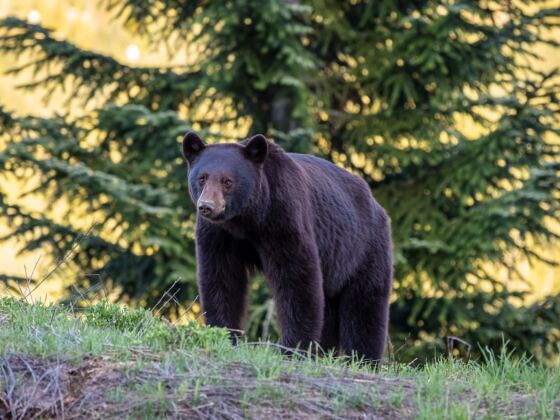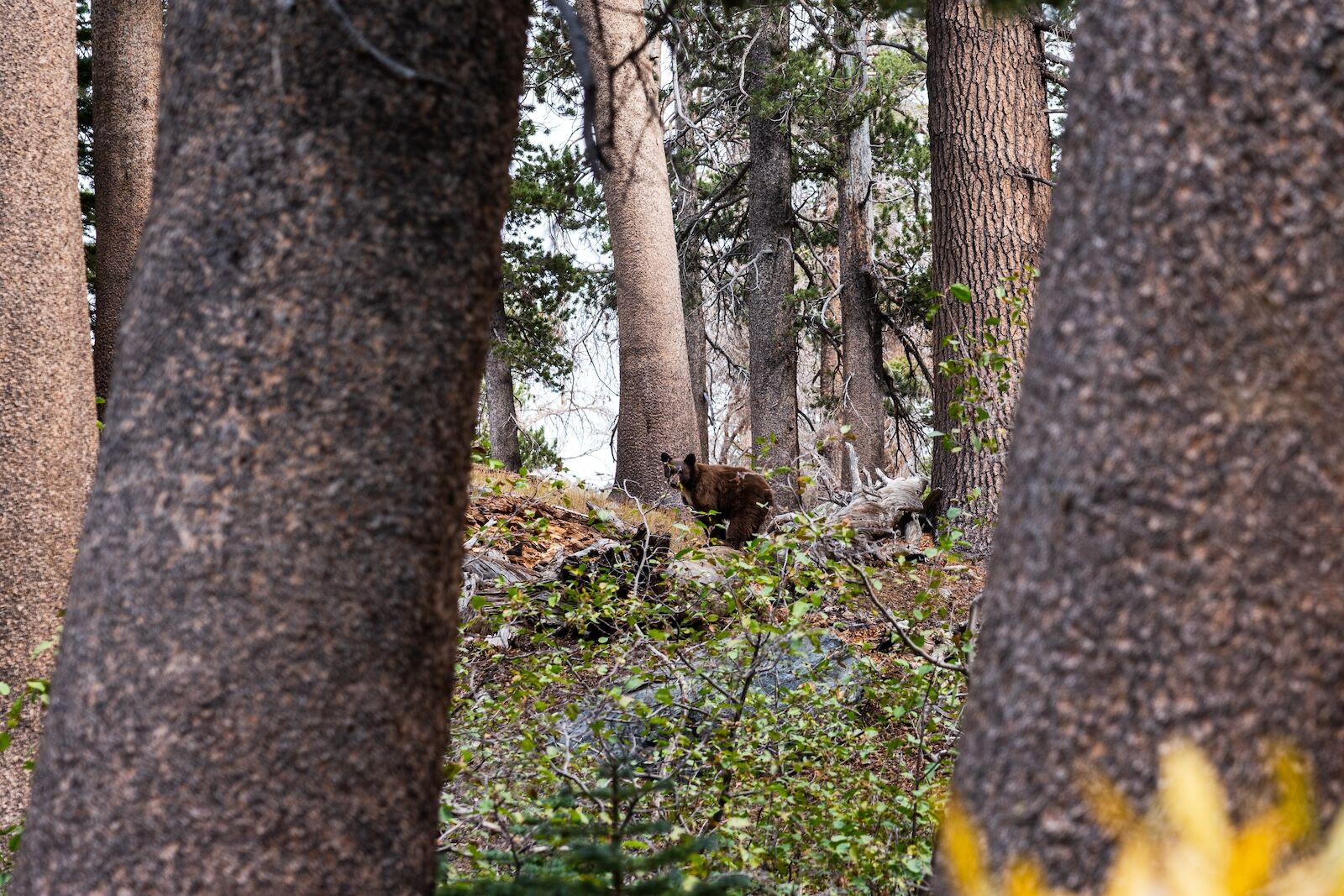In late August, a black bear affectionately called Victor by locals in California was euthanized for swiping at a camper and cutting her leg. The incident happened near Lake Mary, a popular camping spot near Mammoth. The bear had a similar previous incident the same month. The repeat incidents led to the California Department of Fish and Wildlife to determine the bear “had become habituated to human sources of food,” and was “deemed a threat to public safety and was euthanized.” The bear was initially scheduled to be disposed of in a landfill to keep scavengers from ingesting the drugs used. Instead, the Bishop Paiute Tribe relocated the carcass “to a tribal burial site where a ceremonial burial was performed to honor the bear.”


After a Bear Was Euthanized in California's Eastern Sierra Nevada, Attention Turns to Visitor Education
The CDFW did not put blame on Victor the bear and reiterated the proper responses to this type of situation in its public communication.
The following weeks saw a flood of reactions from people sympathetic to the bear — especially after a video of the incident was widely circulated on social media. The woman’s response, as well as the response of the people filming her, was far from accepted public protocol. She didn’t make noise or stay farther than 100 yards away as the bear slowly approached. The video shows people making jokes about the bear eating the food on the table while the woman who was swiped at stood quietly on a stump between the table and the bear box for storing food.
A petition to Mammoth Lakes City Council and the California Department of Fish and Game started on Change.org on August 27 has tens of thousands of signatures from people across the country. One person from Georgia echoed a statement that “we are in the home of these wild animals, not the other way around,” while many blamed the tourist and demanded they be held accountable. Others noted positive experiences with camp hosts who educated guests about bear activity during their stay.
The actions of a few can have an outsized impact on the perception of tourism as a whole, says John Urdi, president and CEO of Mammoth Lakes Tourism. “From a tourism standpoint, we feel a responsibility to educate everybody when they’re coming to town on how to respect both the community and the environment.”
Reaching the right people in the right way
Wildlife interaction education materials are out there and widely circulated. Yellowstone has a humorous approach with some of its campaigns, and the Instagram for the National Parks service is well-loved for it’s comedic approach to wildlife education. In California, the CDFW has a whole subsection of their site called “Bear Naked Truth” for a resource on black bears.
Mammoth Lakes Tourism has its own set of awareness campaigns that build on other wildlife safety resources. Some are directly related to bears, though even the ones centered on a different topic include bear safety information:
- Everything You Need to Know About Bear Safety in Mammoth Lakes
- The No. 1 Tip For Wildlife Viewing in Mammoth Lakes
- Dispersed Camping Just Outside of Mammoth Lakes
- 6 Ways to Camp Responsibly in Mammoth Lakes
- A Beginner’s Guide to Camping in Mammoth Lakes
- Dispersed Camping Just Outside of Mammoth Lakes
- How To Leave No Trace in Mammoth Lakes
- 8 Ways to Recreate Responsibly in the Mountains
Mammoth Lakes Tourism had a lighthearted video series in the works on wildlife interaction this summer. After the incident with Victor the bear, they’re taking a more somber and direct approach.
“I think the challenge right now is that everything is being done for social media.”
“I think a lot of it has to do with the culture these days of people filming what they’re doing with nature,” Urdi says, citing instances of people trying to take selfies with bison in Yellowstone. “I think the challenge right now is that everything is being done for social media. People are trying to do dumber and dumber things to see how many likes they can get or how many hits they can get.”
“The other piece of it is that I think there’s just a lot of lack of common sense,” Urdi later adds.
It feels like examples of this come up every week. Even when confronted with authority figures trying to keep people and wildlife safe, people choose to do it for the video. For example, in Yellowstone, tourists repeatedly ignored a ranger in order to get close enough to a grizzly bear for a phone photo.
Black bear policies in California
In 2022, the California Department of Fish and Wildlife (CDFW) issued an executive summary titled “Black Bear Policy in California: Public Safety, Depredation, Conflict, and Animal Welfare” on the response, methods, and decision-making processes for human-bear conflicts in the state. The paper’s primary goal was two-fold: outline the set of responses for bear interactions, and provide clarity for the staff and public on what actions are taken and why. The timing of the 2022 summary is important and noted at the start: “human/wildlife interactions are increasing, requiring greater staff time in the areas of management and response in the field when interactions occur.”
The paper focuses on the policies for three main situations: public safety, property damage, and interactions with bears that are habituated to human food. It applies to the entirety of California, but includes sections specific to the Lake Tahoe Basin as it has the second-highest density of black bears in North America.
Black bears are the only bears found in California (due to hunting, the last grizzly bear in the state, which is the species on the state flag, was spotted in 1924). The US Forest Service estimates that there are between 25,000 and 35,000 black bears in California.
Black bears are “one of the species most frequently involved in human/wildlife conflict throughout the state,” the CDFW executive summary states, elaborating that “their natural behavior, foraging habits, distribution, and numbers have been altered by human encroachment and access to anthropogenic food sources.” That’s particularly the case in areas like campgrounds where food and garbage can act as an attractant for bears. Climate change and fires are also partly to blame as bears are forced to leave their natural habitat.
The CDFW categorizes bears by their interactions with people. There are orphaned bears that require a specific response, for example, while habituated bears require a different response. One of the highest priority categories from a human safety standpoint is categorized as a “Public Safety Bear.” This applies to an individual bear “demonstrating aggressive action that has resulted in physical contact with a human; or a bear exhibiting an immediate threat to public health and safety, given the totality of the circumstances. Immediate threat refers to a bear that exhibits one or more aggressive behaviors directed toward a person that is not reasonably believed to be due to the presence of responders. Public safety includes situations where a bear remains a threat despite efforts to allow or encourage it through active means to leave the area.”
The summary explains the staff training for responses for everything from wildlife restraint to rehabilitation.
Living with black bears is an ongoing discussion in the area. In April 2024, The CDFW sought public comment on a black bear conservation plan that listed using new wildlife population modeling tools for conservation and adaptive management. It also called for nine Bear Conservation Regions in the state. The goals: “conserving the state’s black bear population and their habitats, recognizing black bears as an important game species, and offering more educational and safe viewing opportunities for the public while minimizing human-black bear conflict.”
How Mammoth is working to improve wildlife interactions in the future

Photo: Lu Yang/Shutterstock
The problem clearly isn’t a lack of messaging. If anything, it’s a lack of attention. If a million people read one Be Bear Aware blog but the person camping in the area doesn’t, then the messaging can’t be effective. Reaching each person is all the more important in campgrounds. Moving forward, Urdi predicts there’s going to be more involved training for campground hosts, and possibly changes to make existing bear signage and handouts (possibly with a response-required safety awareness quiz) more impactful to visitors.
About five years ago, Mammoth Lakes Tourism shifted from being solely a destination marketing agency to more of “a destination stewardship organization” that not only encourages people to visit, but explains what’s expected from them as a visitor. The region’s 2022 Real Unreal marketing campaign centers on keeping the area natural.
“And then when Covid hit, unfortunately we had a lot of disrespectful visitors that came up here,” Urdi says. “It was more ignorance than anything else, because they were people who didn’t know how to interact with nature, whether it’s wildlife, or camping, or fire safety.”
The last two summers have seen the return of more of the pre-pandemic, nature-loving visitors, “but there’s always a tremendous amount of education that has to happen,” Urdi says.
Mammoth Lakes Tourism isn’t trying to bring as many people as possible, but is trying to bring in the people who benefit the community. It’s a balance that places around the world are trying to find as overtourism concerns face a turning point.
“Really what we’re trying to do is bring responsible recreators here, and we’re trying to bring people who are going to benefit the community,” Urdi says. “Seventy percent of the town government’s operating budget comes from visitation.” Urdi adds, “we don’t have manufacturing, we don’t have technology, we don’t have agriculture. We’re a four-square-mile town at 8,000 feet with 7,000 residents. We live and die on visitation, so there needs to be that balance of bringing in people and also making sure that once they get here they’re educated on what’s expected of them to have a symbiotic relationship with our community.”
Tourist numbers to the Mammoth area, and therefore the types of tourists who know what they’re doing outdoors, is starting to normalize to pre-pandemic standards. “But this incident definitely shows that we still have a long way to go as far as the education,” Urdi says.
“What we do is all about stewardship and how you can help us keep this place for generations to come,” Urdi says. “We’re not out here trying to drive as many people as possible, it’s trying to get the right people here who are going to be good to our people, to the environment, and obviously the wildlife that lives out here.”